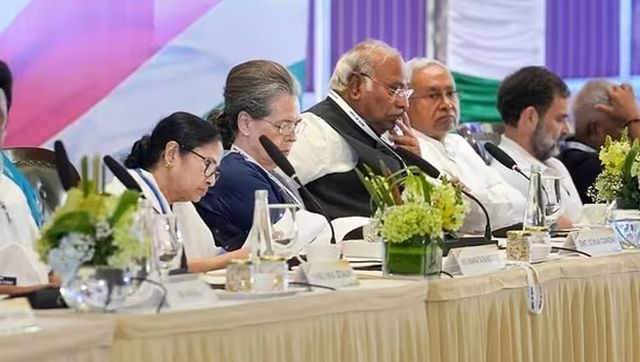Bharat has seen more than 60 coalition governments since 1967, when the first non-Congress government in Uttar Pradesh was formed by the Samyukta Vidhayak Dal alliance with Charan Singh as the chief minister. The first experiment lasted a little over 10 months. Coalitions emerged and have existed in India mainly to keep a strong party or formation out of power. They come up when a political force becomes very strong. Earlier, coalitions were formed against the Congress, now parties come together against the BJP. Quite often, complete ideological strangers have come together to pull the plate from under a bigger dog. In 1977, Bharatiya Jana Sangh and Leftist-socialist forces came together as part of the Morarji Desai government to defeat the Congress after the Emergency. In 1989, the Left and the BJP came together to support the VP Singh government to keep the Congress out. In 2019, the Shiv Sena betrayed the mandate it got going into the elections with the BJP as partner and formed the Maha Vikas Aghadi government with the party’s bitter ideological opponents, the Congress and the NCP. On an average, coalition governments in India have lasted for 26 months. West Bengal’s Left Front regime was a glaring exception. It was the longest serving coalition government which ruled for 34 years between 1977 and 2011. The 9-10 parties were tethered by a convergent Communist-socialist line, and they ruled without the anxiety of having to keep a bigger enemy out. It ruled with such absolute power that for long, the enemy was almost nonexistent. Now, let us look at what is happening to the Opposition I.N.D.I. Alliance. Nitish Kumar has ditched it and gone with the BJP, BRS has deserted it too, Mamata Banerjee has launched a vicious attack on Rahul Gandhi and Congress over the Bharat Jodo Yatra entering Bengal without her knowledge, Udhayanidhi Stalin’s tirade against Sanatan Dharma has made DMK’s non-South partners squirm, Akhilesh Yadav is fuming at the slights from Congress leaders like Kamal Nath, more than half of NCP is with NDA while the patriarch Sharad Pawar and his daughter Supriya Sule are nominally with the Opposition, Jharkhand CM Hemant Soren has been arrested for corruption, Delhi CM Arvind Kejriwal may follow him soon, and RJD chief Lalu Prasad Yadav reluctantly prepares to cool his heels for some more months in the slammer. The alliance is in royal disarray, if not dead already. There are broadly five reasons for this. First, the Congress is the elephant in the room. It still thinks it is bigger than what it currently is, and certainly weightier than others. Both could be misplaced, and 2024 general election results might be the only, albeit unpleasant, way the party rightsizes itself in its own estimation. Second, the Congress’s success could come at the cost of regional parties. Its allies are already alarmed by its success in Karnataka and Telangana feel their space is shrinking or could be cannibalised by the Congress later. Third, there are too many ‘secular’ parties scrambling for the ‘20 per cent’ minority pie. Mamata has spelt it out in as many words, accusing the Congress of trying to steal her Muslim votes. Fourth, the Congress does not have enough heft to carry an ideological hotchpotch. The BJP may get away with breaking a section of the NCP because its otherwise robust Hindutva subsumes the odd minority-leaning ally. The Congress cannot afford either a Shiv Sena trying to ride the Ram wave or a DMK continuously humiliating Hindus. And fifth, the I.N.D.I. Alliance does not have a deft backroom organiser like Harkishan Singh Surjeet of the ’80s and ’90s who brought disparate forces together. Pawar could have played that kind of a role, but he is too old and unwell, besides having the burden of succession to worry about. The Congress’s communication department, led by an irascible Jairam Ramesh, cannot forge a coherent coalition between the party’s goal and its messaging, forget taking allies along. It is a disaster which Rahul Gandhi and Priyanka Gandhi Vadra compound when they are not indifferent. Only the instinct to overcome an existential crisis can save the coalition and bring the Opposition together again. But right now it seems resignation to looming defeat has kicked in more strongly. The author is contributing editor, Firstpost. Views expressed in the above piece are personal and solely that of the author. They do not necessarily reflect Firstpost’s views. Read all the Latest News , Trending News , Cricket News , Bollywood News , India News and Entertainment News here. Follow us on Facebook , Twitter and Instagram .
Limits of coalition politics: Five reasons I.N.D.I. Alliance is falling apart
Abhijit Majumder
• February 3, 2024, 10:16:56 IST
Only the instinct to overcome an existential crisis can save the coalition and bring the Opposition together again. But right now it seems resignation to looming defeat has kicked in more strongly
Advertisement
)
End of Article